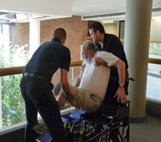IS ASSISTANCE REQUIRED?
Who Will Provide the Assistance?
Anyone in the Office or Building
People with limited mobility who are able to go up and down stairs easily but have trouble operating door locks, latches, and other devices due to limitations of their hands or arms can be assisted by anyone. A viable plan to address this situation may be for the person with the disability to be aware that he or she will need to ask someone for assistance with a particular door or a particular device. It is important to remember that not everyone in a building is familiar with all the various circulation paths everywhere in the building and that they may have to use an unfamiliar one in the event of an emergency.
Specific Person(s) in the Office or Building
-
Friend or coworker
-
Relative
-
Supervisor
-
Building staff
-
Floor safety warden
-
-
First responders
-
Floor safety warden
-
Fire fighter
-
Police officer
-
Emergency medical services: emergency medical technicians (EMTs), ambulance personnel
-
How Many People Are Necessary to Provide Assistance?
One Person
When only one person is necessary to assist a person with limited mobility , a practical plan should identify at least two, ideally more, people who are willing and able to provide assistance. Common sense tells us that a specific person may not be available at any given time due to illness, vacation, an off-site meeting, and so on. The identification of multiple people who are likely to have different working and traveling schedules provides a more reliable plan.
Multiple People
When more than one person is necessary to assist a person with limited mobility, a practical plan should identify at least twice the number of people required who are willing and able to provide assistance. Common sense tells us that one or more specific people may not be available at any given time due to illness, vacation, off-site meetings, and so on. The identification of a pool of people who are likely to have different working and traveling schedules provides a more reliable plan.
What Assistance Will the Person(s) Provide?
Guidance
-
Explaining how and where the person needs to go to get to the usable circulation path
-
Escorting the person to and/or through the usable circulation path
Minor Physical Effort
-
Offering an arm to assist the person to/through the usable circulation path
-
Opening the door(s) in the usable circulation path
Major Physical Effort
-
Operating a stair-descent device
-
Participating in carrying a wheelchair down the stairs
-
Carrying a person down the stairs
Waiting for First Responders
Waiting with the person with limited mobility for first responders would likely be a last choice when there is an imminent threat to people in the building. While first responders do their best to get to a site and the particular location of those needing their assistance, there is no way of predicting how long any given area will remain a safe haven under emergency conditions.
This topic should be discussed in the planning stage. Agreement should be reached regarding how long the person giving assistance is expected to wait for the first responders to arrive. Such discussion is important because waiting too long can endanger more lives. If someone is willing to delay his or her own evacuation to assist a person with limited mobility in an emergency, planning how long that wait might be is wise and reasonable.
Where Will the Person(s) Start Providing Assistance?
From the Location of the Person Requiring Assistance
Does the person providing assistance need to go where the person with limited mobility is located at the time the alarm sounds? If so, how will he or she know where the person needing assistance is?
-
Face to face
-
Phone
-
PDA
-
E-mail
-
Visual
-
Other
From a Specific, Predetermined Location
-
Entry to stairs
-
Other
When Will the Person(s) Provide Assistance?
-
Always
-
Only when asked
-
Other
How Will the Person(s) Providing Assistance Be Contacted?
-
Face to face
-
Phone
-
PDA
-
E-mail
-
Visual
-
Other


User Comments/Questions
Add Comment/Question